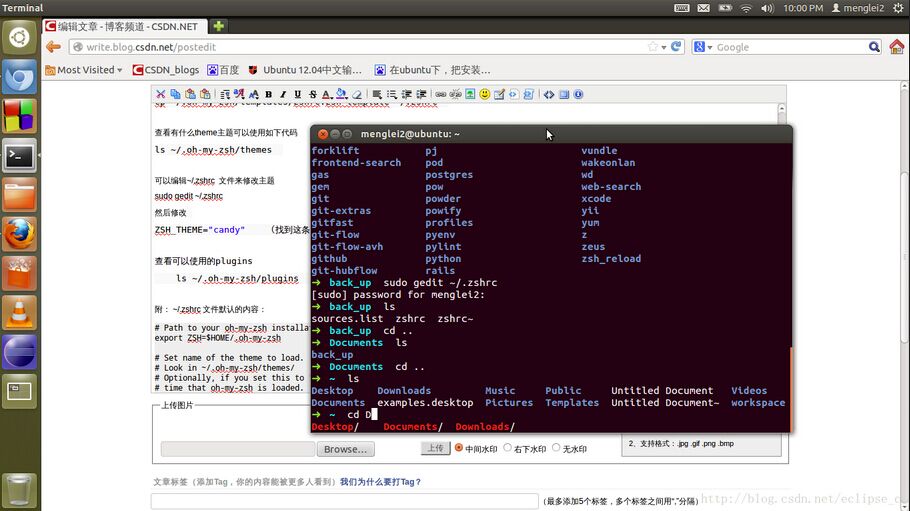之前是记得我同学在我的电脑上帮我配置过炫酷的zsh。
按照这个顺序就可以完成安装!
1.先安装zsh和git
sudo apt-get install zsh git
2.然后把shell切换成zsh,并重启计算机。(注意这个引号,` ` 是tab键上面的那个键)
chsh -s `which zsh`
sudo shutdown -r 0
重启后重新打开终端会提示选择,此时选择q就可以,下次启动还会提示。当然,我们配置完之后,启动就不会提示了。
按下Q继续操作,直到最后一步(chsh -s /bin/zsh)完成
3.查看当前安装的版本(非必要)
zsh --verison
4.从GitHub 下载 oh-my-zsh 套件
git clone https://github.com/robbyrussell/oh-my-zsh.git ~/.oh-my-zsh
5.如果从来没有安装过zsh,可以拷贝oh-my-zsh的范例
cp ~/.oh-my-zsh/templates/zshrc.zsh-template ~/.zshrc
6.查看有什么theme主题可以使用如下代码
ls ~/.oh-my-zsh/themes
7.可以编辑~/.zshrc 文件来修改主题
sudo gedit ~/.zshrc
然后修改
ZSH_THEME="candy"(找到这条语句,然后修改引号内的内容改为candy)
(国外大神对这些主题的截图:https://github.com/robbyrussell/oh-my-zsh/wiki/themes )
8.查看可以使用的plugins
ls ~/.oh-my-zsh/plugins
设置zsh替换掉原有的shell
chsh -s /bin/zsh
ubuntu中默认安装了那些shell?
cat /etc/shells
附: ~/.zshrc 文件默认的内容:
# Path to your oh-my-zsh installation.
export ZSH=$HOME/.oh-my-zsh
# Set name of the theme to load.
# Look in ~/.oh-my-zsh/themes/
# Optionally, if you set this to "random", it'll load a random theme each
# time that oh-my-zsh is loaded.
ZSH_THEME="robbyrussell"
# Uncomment the following line to use case-sensitive completion.
# CASE_SENSITIVE="true"
# Uncomment the following line to disable bi-weekly auto-update checks.
# DISABLE_AUTO_UPDATE="true"
# Uncomment the following line to change how often to auto-update (in days).
# export UPDATE_ZSH_DAYS=13
# Uncomment the following line to disable colors in ls.
# DISABLE_LS_COLORS="true"
# Uncomment the following line to disable auto-setting terminal title.
# DISABLE_AUTO_TITLE="true"
# Uncomment the following line to enable command auto-correction.
# ENABLE_CORRECTION="true"
# Uncomment the following line to display red dots whilst waiting for completion.
# COMPLETION_WAITING_DOTS="true"
# Uncomment the following line if you want to disable marking untracked files
# under VCS as dirty. This makes repository status check for large repositories
# much, much faster.
# DISABLE_UNTRACKED_FILES_DIRTY="true"
# Uncomment the following line if you want to change the command execution time
# stamp shown in the history command output.
# The optional three formats: "mm/dd/yyyy"|"dd.mm.yyyy"|"yyyy-mm-dd"
# HIST_STAMPS="mm/dd/yyyy"
# Would you like to use another custom folder than $ZSH/custom?
# ZSH_CUSTOM=/path/to/new-custom-folder
# Which plugins would you like to load? (plugins can be found in ~/.oh-my-zsh/plugins/*)
# Custom plugins may be added to ~/.oh-my-zsh/custom/plugins/
# Example format: plugins=(rails git textmate ruby lighthouse)
# Add wisely, as too many plugins slow down shell startup.
plugins=(git)
source $ZSH/oh-my-zsh.sh
# User configuration
export PATH=$HOME/bin:/usr/local/bin:$PATH
# export MANPATH="/usr/local/man:$MANPATH"
# You may need to manually set your language environment
# export LANG=en_US.UTF-8
# Preferred editor for local and remote sessions
# if [[ -n $SSH_CONNECTION ]]; then
# export EDITOR='vim'
# else
# export EDITOR='mvim'
# fi
# Compilation flags
# export ARCHFLAGS="-arch x86_64"
# ssh
# export SSH_KEY_PATH="~/.ssh/dsa_id"
# Set personal aliases, overriding those provided by oh-my-zsh libs,
# plugins, and themes. Aliases can be placed here, though oh-my-zsh
# users are encouraged to define aliases within the ZSH_CUSTOM folder.
# For a full list of active aliases, run `alias`.
#
# Example aliases
# alias zshconfig="mate ~/.zshrc"
# alias ohmyzsh="mate ~/.oh-my-zsh"
现在的样子:


